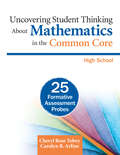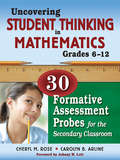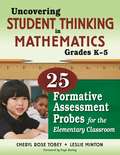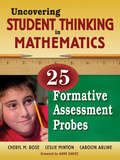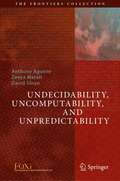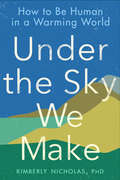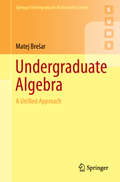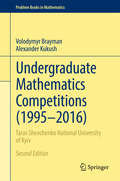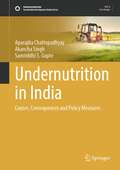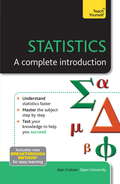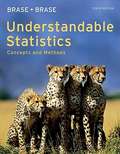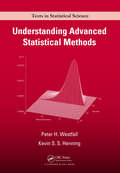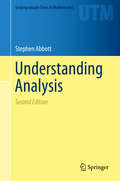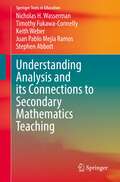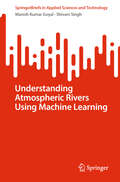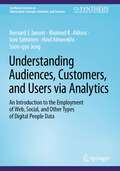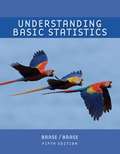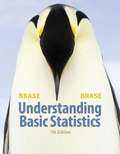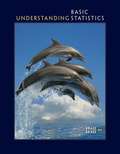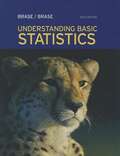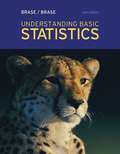- Table View
- List View
Uncovering Student Thinking About Mathematics in the Common Core, High School: 25 Formative Assessment Probes
by Cheryl Rose Tobey Carolyn B. ArlineTake the guesswork out of high school math instruction! Quickly and reliably uncover common math misconceptions in Grades 9-12 with these convenient and easy-to-implement diagnostic tools! Bestselling authors Cheryl Rose Tobey and Carolyn B. Arline provide 25 new assessment probes that pinpoint subconcepts within the Common Core State Standards to promote deep learning and expert math instruction—all while learning is underway. Completely Common Core aligned, these grade-specific probes eliminate the guesswork and will help you Systematically address conceptual and procedural mistakes Pinpoint where students are struggling Plan targeted instruction in algebra, functions, logarithms, geometry, trigonometric ratios, statistics and probability, and more
Uncovering Student Thinking in Mathematics, Grades 6-12: 30 Formative Assessment Probes for the Secondary Classroom
by Cheryl Rose Tobey Carolyn B. ArlineDiscussing standards, research, and more, these 30 probes help secondary teachers assess students' grasp of core mathematics concepts and modify their instruction to improve student achievement.
Uncovering Student Thinking in Mathematics, Grades K-5: 25 Formative Assessment Probes for the Elementary Classroom
by Cheryl Rose Tobey Leslie G. MintonThis book provides 25 easily administered assessments of learners' math knowledge that help teachers monitor learning in real time and improve all students' math skills.
Uncovering Student Thinking in Mathematics: 25 Formative Assessment Probes
by Cheryl Rose Tobey Leslie G. Minton Carolyn B. ArlineAppropriate for all grade levels, these 25 field-tested, easy-to-use mathematics assessment probes help teachers modify instruction by determining students' understanding of core mathematical concepts.
Undecidability, Uncomputability, and Unpredictability (The Frontiers Collection)
by Anthony Aguirre Zeeya Merali David SloanFor a brief time in history, it was possible to imagine that a sufficiently advanced intellect could, given sufficient time and resources, in principle understand how to mathematically prove everything that was true. They could discern what math corresponds to physical laws, and use those laws to predict anything that happens before it happens. That time has passed. Gödel’s undecidability results (the incompleteness theorems), Turing’s proof of non-computable values, the formulation of quantum theory, chaos, and other developments over the past century have shown that there are rigorous arguments limiting what we can prove, compute, and predict. While some connections between these results have come to light, many remain obscure, and the implications are unclear. Are there, for example, real consequences for physics — including quantum mechanics — of undecidability and non-computability? Are there implications for our understanding of the relations between agency, intelligence, mind, and the physical world? This book, based on the winning essays from the annual FQXi competition, contains ten explorations of Undecidability, Uncomputability, and Unpredictability. The contributions abound with connections, implications, and speculations while undertaking rigorous but bold and open-minded investigation of the meaning of these constraints for the physical world, and for us as humans.
Under the Sky We Make: How to Be Human in a Warming World
by Kimberly NicholasIt's warming. It's us. We're sure. It's bad. But we can fix it.After speaking to the international public for close to fifteen years about sustainability, climate scientist Dr. Nicholas realized that concerned people were getting the wrong message about the climate crisis. Yes, companies and governments are hugely responsible for the mess we're in. But individuals CAN effect real, significant, and lasting change to solve this problem. Nicholas explores finding purpose in a warming world, combining her scientific expertise and her lived, personal experience in a way that seems fresh and deeply urgent: Agonizing over the climate costs of visiting loved ones overseas, how to find low-carbon love on Tinder, and even exploring her complicated family legacy involving supermarket turkeys.In her astonishing book Under the Sky We Make, Nicholas does for climate science what Michael Pollan did more than a decade ago for the food on our plate: offering a hopeful, clear-eyed, and somehow also hilarious guide to effecting real change, starting in our own lives. Saving ourselves from climate apocalypse will require radical shifts within each of us, to effect real change in our society and culture. But it can be done. It requires, Dr. Nicholas argues, belief in our own agency and value, alongside a deep understanding that no one will ever hand us power--we're going to have to seize it for ourselves.
Undergraduate Algebra: A Unified Approach (Springer Undergraduate Mathematics Series)
by Matej BrešarThis textbook offers an innovative approach to abstract algebra, based on a unified treatment of similar concepts across different algebraic structures. This makes it possible to express the main ideas of algebra more clearly and to avoid unnecessary repetition.The book consists of two parts: The Language of Algebra and Algebra in Action. The unified approach to different algebraic structures is a primary feature of the first part, which discusses the basic notions of algebra at an elementary level. The second part is mathematically more complex, covering topics such as the Sylow theorems, modules over principal ideal domains, and Galois theory.Intended for an undergraduate course or for self-study, the book is written in a readable, conversational style, is rich in examples, and contains over 700 carefully selected exercises.
Undergraduate Mathematics Competitions (1995–2016)
by Alexander Kukush Volodymyr BraymanVersatile and comprehensive in content, this book of problems will appeal to students in nearly all areas of mathematics. The text offers original and advanced problems proposed from 1995 to 2016 at the Mathematics Olympiads. Essential for undergraduate students, PhD students, and instructors, the problems in this book vary in difficulty and cover most of the obligatory courses given at the undergraduate level, including calculus, algebra, geometry, discrete mathematics, measure theory, complex analysis, differential equations, and probability theory. Detailed solutions to all of the problems from Part I are supplied in Part II, giving students the ability to check their solutions and observe new and unexpected ideas. Most of the problems in this book are not technical and allow for a short and elegant solution. The problems given are unique and non-standard; solving the problems requires a creative approach as well as a deep understanding of the material. Nearly all of the problems are originally authored by lecturers, PhD students, senior undergraduates, and graduate students of the mechanics and mathematics faculty of Taras Shevchenko National University of Kyiv as well as by many others from Belgium, Canada, Great Britain, Hungary, and the United States.
Undernutrition in India: Causes, Consequences and Policy Measures (Sustainable Development Goals Series)
by Aparajita Chattopadhyay Akancha Singh Samriddhi S. GupteThis book deals with issues related to undernutrition and anaemia in India. It establishes its interconnectedness with poverty, tribal living conditions, contraception usage, dietary diversity, and socioeconomic inequality. It addresses SDG 2, namely “end hunger, achieve food security and improved nutrition, and promote sustainable agriculture.” It puts forth the linkages between mother's economic empowerment and children's nutritional status, anaemia of women with particular reference to tribal women, and the issues associated with anaemia in India. It also delves into the relationship between contraceptive usage and anaemia level. It explores the proximate and intermediate determinants of undernutrition disaggregated at the state level in India. It elaborates the importance of ensuring food security and suggests policy measures to improve maternal and child health. The book is an asset for all researchers, academicians, clinicians and policy makers dealing with sociology, economics, public policy, social work, population study, gender issues, biostatistics, health, development, and nutrition.
Understand Statistics: Teach Yourself
by Alan GrahamDo you want to better understand the statistics you hear everyday - and recognise if you're being misled? Here is a straightforward introduction to the principles of this vital field of mathematics. Assuming minimal knowledge and using examples from a wide variety of everyday contexts, this book makes even complex concepts and techniques easy to grasp.NOT GOT MUCH TIME?One, five and ten-minute introductions to key principles to get you started.AUTHOR INSIGHTSLots of instant help with common problems and quick tips for success, based on the author's many years of experience.TEST YOURSELFTests in the book and online to keep track of your progress.EXTEND YOUR KNOWLEDGEExtra online articles at www.teachyourself.com to give you a richer understanding of psychology.FIVE THINGS TO REMEMBERQuick refreshers to help you remember the key facts.TRY THISInnovative exercises illustrate what you've learnt and how to use it.
Understand Statistics: Teach Yourself
by Alan GrahamDo you want to better understand the statistics you hear everyday - and recognise if you're being misled? Here is a straightforward introduction to the principles of this vital field of mathematics. Assuming minimal knowledge and using examples from a wide variety of everyday contexts, this book makes even complex concepts and techniques easy to grasp.NOT GOT MUCH TIME?One, five and ten-minute introductions to key principles to get you started.AUTHOR INSIGHTSLots of instant help with common problems and quick tips for success, based on the author's many years of experience.TEST YOURSELFTests in the book and online to keep track of your progress.EXTEND YOUR KNOWLEDGEExtra online articles at www.teachyourself.com to give you a richer understanding of psychology.FIVE THINGS TO REMEMBERQuick refreshers to help you remember the key facts.TRY THISInnovative exercises illustrate what you've learnt and how to use it.
Understandable Statistics: Concepts and Methods
by Charles Henry Brase Corrinne Pellillo BraseUnderstandable Statistics is a thorough, yet approachable statistics text. Designed to help students overcome their apprehension about statistics, the text provides guidance and informal advice showing students the links between statistics and their everyday lives. To reinforce this approach, the book integrates real-life data selected from a variety of sources including journals, periodicals, newspapers and the Internet. The use of graphing calculators, Excel, Minitab and SPSS is covered, but not required. A set of technology resources accompanying the Eighth Edition, designed to provide reinforcement for struggling students, includes a market-leading video and DVD series, interactive lessons, and simulations.
Understandable Statistics: Concepts and Methods (Tenth Edition)
by Charles Henry Brase Corrinne Pellillo BraseUnderstandable Statistics: Concepts and Methods, Tenth Edition is a thorough, yet accessible program designed to help readers overcome their apprehensions about statistics. The authors provide clear guidance and informal advice while showing the links between statistics and the world.
Understandable Statistics: Concepts and Methods, Advanced Placement High School Edition (7th Edition)
by Charles Henry Brase Corrinne Pellillo BraseThe seventh edition of Understandable Statistics: Concepts and Methods continues to emphasize concepts of statistics. Statistical methods are carefully presented with a focus on understanding both the suitability of the method and the meaning of the result. Statistical methods and measurements are developed in the context of applications.
Understanding Advanced Statistical Methods (Chapman & Hall/CRC Texts in Statistical Science)
by Peter Westfall Kevin S. HenningProviding a much-needed bridge between elementary statistics courses and advanced research methods courses, Understanding Advanced Statistical Methods helps students grasp the fundamental assumptions and machinery behind sophisticated statistical topics, such as logistic regression, maximum likelihood, bootstrapping, nonparametrics, and Bayesian me
Understanding Analysis
by Stephen AbbottThis lively introductory text exposes the student to the rewards of a rigorous study of functions of a real variable. In each chapter, informal discussions of questions that give analysis its inherent fascination are followed by precise, but not overly formal, developments of the techniques needed to make sense of them. By focusing on the unifying themes of approximation and the resolution of paradoxes that arise in the transition from the finite to the infinite, the text turns what could be a daunting cascade of definitions and theorems into a coherent and engaging progression of ideas. Acutely aware of the need for rigor, the student is much better prepared to understand what constitutes a proper mathematical proof and how to write one. Fifteen years of classroom experience with the first edition of Understanding Analysis have solidified and refined the central narrative of the second edition. Roughly 150 new exercises join a selection of the best exercises from the first edition, and three more project-style sections have been added. Investigations of Euler's computation of ζ(2), the Weierstrass Approximation Theorem, and the gamma function are now among the book's cohort of seminal results serving as motivation and payoff for the beginning student to master the methods of analysis. Review of the first edition: "This is a dangerous book. Understanding Analysis is so well-written and the development of the theory so w ell-motivated that exposing students to it could well lead them to expect such excellence in all their textbooks. . . . Understanding Analysis is perfectly titled; if your students read it, that's what's going to happen. . . . This terrific book will become the text of choice for the single-variable introductory analysis course . . . " -- Steve Kennedy, MAA Reviews
Understanding Analysis and its Connections to Secondary Mathematics Teaching (Springer Texts in Education)
by Stephen Abbott Nicholas H. Wasserman Timothy Fukawa-Connelly Keith Weber Juan Pablo Mejía RamosGetting certified to teach high school mathematics typically requires completing a course in real analysis. Yet most teachers point out real analysis content bears little resemblance to secondary mathematics and report it does not influence their teaching in any significant way. This textbook is our attempt to change the narrative. It is our belief that analysis can be a meaningful part of a teacher's mathematical education and preparation for teaching. This book is a companion text. It is intended to be a supplemental resource, used in conjunction with a more traditional real analysis book.The textbook is based on our efforts to identify ways that studying real analysis can provide future teachers with genuine opportunities to think about teaching secondary mathematics. It focuses on how mathematical ideas are connected to the practice of teaching secondary mathematics–and not just the content of secondary mathematics itself. Discussions around pedagogy are premised on the belief that the way mathematicians do mathematics can be useful for how we think about teaching mathematics. The book uses particular situations in teaching to make explicit ways that the content of real analysis might be important for teaching secondary mathematics, and how mathematical practices prevalent in the study of real analysis can be incorporated as practices for teaching.This textbook will be of particular interest to mathematics instructors–and mathematics teacher educators–thinking about how the mathematics of real analysis might be applicable to secondary teaching, as well as to any prospective (or current) teacher who has wondered about what the purpose of taking such courses could be.
Understanding Atmospheric Rivers Using Machine Learning (SpringerBriefs in Applied Sciences and Technology)
by Manish Kumar Goyal Shivam SinghThis book delves into the characterization, impacts, drivers, and predictability of atmospheric rivers (AR). It begins with the historical background and mechanisms governing AR formation, giving insights into the global and regional perspectives of ARs, observing their varying manifestations across different geographical contexts. The book explores the key characteristics of ARs, from their frequency and duration to intensity, unraveling the intricate relationship between atmospheric rivers and precipitation. The book also focus on the intersection of ARs with large-scale climate oscillations, such as El Niño and La Niña events, the North Atlantic Oscillation (NAO), and the Pacific Decadal Oscillation (PDO). The chapters help understand how these climate phenomena influence AR behavior, offering a nuanced perspective on climate modeling and prediction. The book also covers artificial intelligence (AI) applications, from pattern recognition to prediction modeling and early warning systems. A case study on AR prediction using deep learning models exemplifies the practical applications of AI in this domain. The book culminates by underscoring the interdisciplinary nature of AR research and the synergy between atmospheric science, climatology, and artificial intelligence
Understanding Audiences, Customers, and Users via Analytics: An Introduction to the Employment of Web, Social, and Other Types of Digital People Data (Synthesis Lectures on Information Concepts, Retrieval, and Services)
by Bernard J. Jansen Joni Salminen Kholoud K. Aldous Hind Almerekhi Soon-gyo JungThis book presents the foundations of using analytics from the laboratory, social media platforms, and the web. The authors cover key topics including analytics strategy, data gathering approaches, data preprocessing, data quality assessment, analytical methods, tools, and validation methods. The book includes chapters explaining web analytics, social media analytics, and how to create an analytics strategy. The authors also cover on data sources, such as online surveys, crowdsourcing, eye tracking, mouse tracking, social media APIs, search logs, and analytics triangulation. The book also discusses analytical tools for social media analytics, search analytics, persona analytics, user studies, and website analytics. The authors conclude by examining the validity of online analytics.
Understanding Basic Statistics
by Charles Henry Brase Corrinne Pellillo BraseA condensed and more streamlined version of the very popular and widely used UNDERSTANDABLE STATISTICS, Ninth Edition, this book offers instructors an effective way to teach the essentials of statistics, including early coverage of Regression, within a more limited time frame. Designed to help students overcome their apprehension about statistics, UNDERSTANDING BASIC STATISTICS, Fifth Edition, is a thorough yet approachable text that provides plenty of guidance and informal advice demonstrating the links between statistics and the world. The strengths of the text include an applied approach that helps students realize the real-world significance of statistics, an accessible exposition, and a new, complete technology package. The Fifth Edition addresses the growing importance of developing students' critical thinking and statistical literacy skills with the introduction of new features and exercises throughout the text. The use of the graphing calculator, Microsoft Excel, Minitab, and SPSS is covered but not required.
Understanding Basic Statistics
by Charles Henry Brase Corrinne Pellillo BraseNIMAC-sourced textbook
Understanding Basic Statistics
by Charles Henry Brase Corrinne Pellillo BraseNIMAC-sourced textbook
Understanding Basic Statistics
by Charles Henry Brase Corrinne Pellillo BraseUNDERSTANDING BASIC STATISTICS provides plenty of guidance and informal advice as it demonstrates the links between statistics and the real world. Its reader-friendly approach helps you grasp the concepts and see how they relate to your life. A complete technology package, including JMP statistical software, gives you the tools you need to practice what you're learning and succeed in the course.
Understanding Basic Statistics
by Charles Henry Brase Corrinne Pellillo BraseNIMAC-sourced textbook
Understanding Basic Statistics Sixth Edition
by Charles Henry Brase Corrinne Pellillo BraseUNDERSTANDING BASIC STATISTICS, Sixth Edition, provides plenty of guidance and informal advice demonstrating the links between statistics and the real world. Thorough yet abbreviated, the text offers a reader-friendly style and a new, complete technology package to supplement learning.
